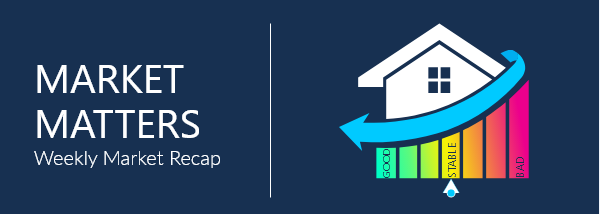Market Matters

Hot inflation numbers came to us in the form of much higher PPI and CPI this week. This helped push the 10-year yield higher this week to 1.659. Most likely, the discussion of the markets for the near future will be a question of whether the rise in prices is transitory or not. As we get more workers back into the economy, that will help with the supply shortages; however, we are seeing bottlenecks in factories across the world. To go along with the potential inflation issue, we also have plenty of people still out of work as reflected by the recent weak jobs report. Until there is more data on how the economy is progressing, we are in a holding pattern from the Fed. The Fed on hold, in theory, should keep rates lower. As we have seen this week, if the market expects inflation to get out of control with the extra accommodative monetary policy, that will push the 10-year higher, so best to be careful.
 Initial Jobless Claims
Initial Jobless Claims
Initial Jobless Claims fell by -34k to 473k for the week ending May 8th vs. the upwardly revised count of 507k in the prior week (orig. 498k). This is now the lowest level for claims since the week of March 14, 2020 (256k). The 4-week moving average now sits at 534k, which is a decline of -28.3k from the prior week. Continuing claims, which lag by a week, fell -45k to 3.655mln, with the 4-week moving average now at 3.665mln, a drop of -13.3k from the prior week’s revised 3.676mln. This is the lowest level for the average since the week of March 28, 2020.
 Producer Price Index
Producer Price Index
According to the BLS, PPI (Producer Price Index) for April rose +.6% on headline, with the core index (ex-food/energy/trade) up +.7%. Looking YoY, headline inflation at the wholesale levels rose to +6.2% from +4.2%, with the core rate up to +4.1% from a prior +3.1%. These are the largest YoY increases since 2010, and 2014, respectively. About two-thirds of the April advance can be attributed to a +.6% increase in prices for final demand services, while the index for final demand goods also rose by +.6%. Within the index for services, airline passenger services, food retailing, fuels and lubricants retailing, physician care, and hardware/building materials/supplies retailing all moved higher. On the good side, steel mill products, prices for beef and veal, pork, residential natural gas, plastics, and dairy products all increased on the month. Worth noting on the negative side was a drop in gasoline, which mirrors the consumer side drop in energy in yesterday’s report. Overall, a hotter than expected report which will certainty add to the CPI numbers and will continue to fuel the discussion of if the current spike is transitory or not.
 CPI
CPI
CPI for April was way higher than expected, rising by +.8% on headline. Looking YoY, headline CPI is now up +4.2% compared to the YoY rate in March of +2.6% and is now the sharpest increase in that measure since 2008. Food prices rose in April, while energy was down on the month. As the details in the report showed firm prices across most sectors, the surge in autos was a main driver. The cost of used cars and trucks was up +10%, making it the largest monthly increase since 1953, and accounted for more than a third of the increase in headline CPI for April. As we know, chip shortages have disrupted auto supply, slimming out inventories as carmakers have been forced to cut back production. Back into the details, core prices, which exclude food and energy, were up +.9% on the month. This moved the YoY rate up to +3.0% from a prior +1.6%, making it the sharpest gain for core prices since 1996. While autos drove most of the core gains, goods prices were up +2.0%, education and communication items up +3.1%, commodities up +1.2%, and medical care goods up +.6%. In core services, prices rose +.54% in April, posting the strongest month since 1992. Other gains worth mentioning were the cost of lodging away from home rose +7.6%, airfare rose +10.2%, and car rental costs were up +16.2%. Overall, consumer prices were expected to surge higher, mostly as a result of more re-openings, vaccinations, stimulus payments, etc. While the Fed believes and has cautioned that short-term price increases will be seen, expectations are that prices will start to cool back down as supply chains open back up and recent stimulus boosts start to fade out.
 JOLTS Report
JOLTS Report
The JOLTS Report for March showed the number of job openings reached a series high of 8.1mln (+597k) on the last business day of the month. The job openings rate increased to 5.3% with the largest increases in accommodation and food services, state and local government education, and arts, entertainment, and recreation. Hires were little changed at 6.0mln, with separations little changed as well at 5.3mln. Within separations, the quits rate was unchanged at 2.4%, while layoffs and discharges decreased to a series low of 1%. Over the 12 months ending in March, hires totaled 73.2mln and separations totaled 69.9mln, resulting in a net employment gain of 3.3mln. These totals include workers who may have been hired and separated more than once during the year.

